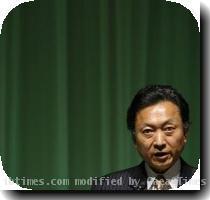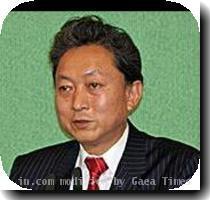Sinking of SKorean ship, China military might seen as factors in Japanese PM’s base decision
By Malcolm Foster, APMonday, May 24, 2010
Korean tension a factor in Japan base decision
TOKYO — Japan’s prime minister suggested Monday that heightened tensions on the Korean peninsula contributed to his decision to break a campaign promise and keep a key U.S. Marine base in Okinawa. Analysts say China’s growing military assertiveness may also have played a role.
U.S. Secretary of State Hillary Rodham Clinton, traveling in Beijing, commended Prime Minister Yukio Hatoyama for making “the difficult but nevertheless correct decision” Sunday to keep Marine Corps Air Station Futenma on the strategically important island, which is close to Taiwan and the Chinese mainland and not far from the Korean peninsula.
“I thank him for his courage and determination to fulfill his commitments. This is truly the foundation for our future work as allies in the Asia-Pacific region,” she said from Beijing.
U.S. officials traveling with Clinton, who visited Tokyo on Friday, said the March sinking of the South Korean warship Cheonan — blamed on a North Korean torpedo — had deepened the understanding among Japanese officials about the importance of the U.S. military presence in Okinawa. The island hosts more than half the 47,000 American troops in Japan under a mutual security pact.
Recent examples of China’s military flexing its muscle may have also been a factor in pushing Hatoyama to reverse his stance and reach an uncomfortable decision — which could contribute to his resignation in coming weeks or months amid plunging approval ratings.
In April, Chinese ships were spotted in international waters off Okinawa. A Chinese helicopter also came within 300 feet (90 meters) of a Japanese military monitoring vessel in the vicinity of a Chinese naval exercise.
“Without a doubt the sinking of the Cheonan, but probably more importantly the two Chinese incursions within a month … certainly give him good political cover and … make it obvious that finding a solution quickly to Futenma is in Japan’s national interests,” said Malcolm Cook, the East Asia program director at the Lowy Institute, a Sydney-based think tank.
“It also shows that this is an imminent issue that you can’t keep kicking down the road,” Cook added.
Whatever the real reasoning, recent events make it easier for Hatoyama to make a case to the Japanese public.
The prime minister came to office last September promising to move the Marine base off the island, going against a 2006 agreement with Washington to transfer it to Henoko, in a less crowded, northern part of Okinawa.
But after months of searching and fruitless discussions with U.S. and Okinawan officials, Hatoyama said Sunday during a visit to the island that Futenma’s facilities would be moved to the vicinity of Henoko, disappointing tens of thousands of island residents who complain about base-related noise, pollution and crime.
U.S. military officials and security experts argue it is essential that Futenma remain on Okinawa because its helicopters and air assets support Marine infantry units based on the island. Moving the facility off the island could slow the Marines’ coordination and response in times of emergency.
Hatoyama, who had set an end-of-May deadline to resolve Futenma’s relocation, hinted Monday that recent events played a role in his thinking.
“When one considers the current situation on the Korean peninsula and in Asia, I believe what is of utmost importance is to place U.S.-Japan relations on a secure relationship of trust, and that is why I made this decision” to keep the base in Okinawa, he told reporters.
Hatoyama said the new plan — which officials are expected to reveal Friday — would not be identical to the 2006 plan, which called for two airstrips to be built on reclaimed land off the coast near Henoko. Details such as actual location and manner of construction have yet to be decided.
The Futenma move is part of a broader plan to reorganize American troops in Japan that includes moving 8,000 Marines to the U.S. territory of Guam by 2014. But U.S. officials say that unless the Futenma issue is resolved, the other pieces cannot move forward.
Furious local opposition to Futenma’s move could make it difficult to forge ahead on executing the plan, even if the two governments strike a deal. During Hatoyama’s Sunday visit, protesters held aloft signs emblazoned with the Japanese character for “anger,” and thousands have gathered to demonstrate in recent months.
“It’s probably very hard, almost undoable” given the vehement opposition, said Koichi Nakano, a political science professor at Sophia University in Tokyo. “Even the Americans, I suspect realize that.”
Hatoyama’s flip-flop on Futenma further solidifies public perceptions that he is a weak and indecisive leader, and could lead to his exit.
He entered office amid high hopes and soaring approval ratings after his party crushed the long-ruling conservative Liberal Democratic Party last August. But his mishandling of Futenma, a political funds scandal and failure to achieve campaign promises, such as making expressways toll-free, have caused his approval ratings to plunge into the 20-percent range.
Some experts see Hatoyama staying on through upper house elections that must be held around July. He could step down should his Democratic Party of Japan do poorly — or perhaps later at the DPJ’s party leadership election, likely in September.
“His days are pretty numbered. I don’t think he’ll be the leader of Japan beyond that scenario,” said Sheila Smith, a senior fellow for Japan studies at the Council on Foreign Relations in Washington.
Still, the way the U.S., Japan as well as South Korea came together over the last week to hold North Korea accountable for the sinking of the Cheonan shows the dispute over Futenma hasn’t crippled the 50-year-old U.S.-Japan military alliance, Smith said.
“The good news for the past week is that when it matters this relationship can focus on the crisis management side,” she said.
Associated Press writer Matthew Lee in Beijing contributed to this report.
(This version CORRECTS distance of Chinese helicopter in graf 6)
Tags: Asia, Beijing, China, East Asia, Emergency Management, Greater China, International Incidents, Japan, North America, North Korea, Political Approval Ratings, South Korea, Tokyo, United States, Yukio Hatoyama


